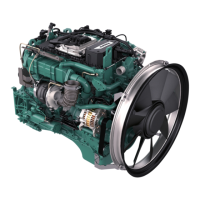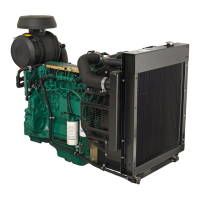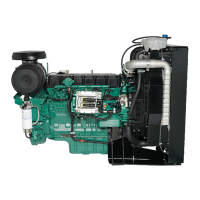Do you have a question about the Volvo Penta TAD560VE and is the answer not in the manual?
Purpose and overview of the operator's manual.
Details on the engine's limited warranty and owner responsibilities.
Explanation of safety text priority levels (Danger, Warning, Caution, Important, Notice).
Guidelines on wearing protective gear like gloves, goggles, and clothing.
Safety measures for protecting eyes from hazards like sparks and chemical splashes.
Precautions to prevent skin damage from oil exposure and corrosive substances.
Precautions against fuel vapors, flammable materials, and ignition sources.
Warning about hazards associated with moving engine parts and hot surfaces.
Warning against using start spray due to explosion risk.
Essential checks and precautions before starting the engine.
Safety measures for working on the engine's electrical system.
Safety measures before welding, cooling/oil system work, and refueling.
Warnings and precautions when dealing with hot coolant or oil under pressure.
Safety guidelines for fuel quality, leak detection, and handling fuel pipes.
Procedures for safe handling, polarity, and risks associated with batteries.
Importance of correct battery pole connection to prevent damage.
Hazards associated with battery electrolyte and first aid measures.
Safety considerations for cleaning engine components and sensitive parts.
Safety precaution for adjusting the clutch with the engine stopped.
Overview of the manual's content and engine warranty obligations.
Initial engine run-in procedures and recommendations for fuel, oil, and coolant.
Importance of regular servicing, genuine parts, and avoiding product strain.
Volvo Penta's commitment to environmental care and low emissions.
Special demands for emission-certified engines regarding care and maintenance.
Information on authorized dealers and 24-hour breakdown support.
General description of the industrial engines, including their type and features.
Explanation of the electronic EMS for engine control, diagnostics, and fuel management.
Details on SCR technology and AdBlue/DEF for emission reduction.
Information on AdBlue/DEF solution, quality standards, and system monitoring.
Identification of key components within the Exhaust Aftertreatment System.
Explanation of the SCR system's operating principle.
Details on the AdBlue/DEF tank, level monitoring, and heating system for cold weather.
Overview of the optional DCU for engine monitoring and control.
Navigation and functions within the DCU menus, including engine data display.
Configuration of application, units, language, alarms, and throttle settings.
Detailed description of the DU, its display modes, and contrast adjustment.
Role of the CIU as a translator between EMS and control panel.
List of available Easy Link instruments for monitoring engine parameters.
Essential checks before starting the engine to ensure safety and proper operation.
Step-by-step guide for starting the engine with or without pre-heating.
Preparations and recommendations for starting the engine in very cold weather.
Warnings against start spray and procedures for using auxiliary batteries.
How to read instruments and understand system alarms and fault indications.
Techniques for maneuvering and guidelines to avoid issues with low load operation.
Steps to take before shutting down the engine for optimal performance and longevity.
Actions after engine shutdown, including leak checks and preparing for longer stops.
How faults are displayed on the DU and the process to acknowledge them.
Locating, understanding, and clearing fault codes using diagnostic tools.
Specific warnings and inducements related to the EATS and DEF system.
A register listing fault codes (SPN, PID, FMI) for the EATS system.
Overview of service intervals and recommended maintenance tasks for engine reliability.
Routine visual checks of the engine and compartment for potential issues.
Step-by-step guide for replacing the engine air filter.
Procedures for inspecting charge air pipes and checking/changing the drive belt.
Procedures for checking oil levels, changing oil, and replacing the oil filter.
Maintenance tasks for the fuel system, including filter changes and bleeding.
Procedures for maintaining the cooling system, including coolant checks and cleaning.
Instructions for filling, handling, and cleaning the AdBlue/DEF system.
Maintenance and safety procedures for the electrical system, including batteries.
Guidelines for preserving the engine during long periods of non-operation.
Key technical data for the engine models, including bore, stroke, and power.
Specifications for oil change volume, pressure, filter, and recommendations.
Requirements for fuel quality, including diesel and paraffinic fuels, for aftertreatment systems.
Technical details for the cooling system, including pressure cap and thermostat settings.
Parameters for water quality used in coolant mixtures, according to ASTM D4985.
System voltage and alternator specifications.
Information on locating and identifying engine plates and serial numbers.
Purpose and overview of the operator's manual.
Details on the engine's limited warranty and owner responsibilities.
Explanation of safety text priority levels (Danger, Warning, Caution, Important, Notice).
Guidelines on wearing protective gear like gloves, goggles, and clothing.
Safety measures for protecting eyes from hazards like sparks and chemical splashes.
Precautions to prevent skin damage from oil exposure and corrosive substances.
Precautions against fuel vapors, flammable materials, and ignition sources.
Warning about hazards associated with moving engine parts and hot surfaces.
Warning against using start spray due to explosion risk.
Essential checks and precautions before starting the engine.
Safety measures for working on the engine's electrical system.
Safety measures before welding, cooling/oil system work, and refueling.
Warnings and precautions when dealing with hot coolant or oil under pressure.
Safety guidelines for fuel quality, leak detection, and handling fuel pipes.
Procedures for safe handling, polarity, and risks associated with batteries.
Importance of correct battery pole connection to prevent damage.
Hazards associated with battery electrolyte and first aid measures.
Safety considerations for cleaning engine components and sensitive parts.
Safety precaution for adjusting the clutch with the engine stopped.
Overview of the manual's content and engine warranty obligations.
Initial engine run-in procedures and recommendations for fuel, oil, and coolant.
Importance of regular servicing, genuine parts, and avoiding product strain.
Volvo Penta's commitment to environmental care and low emissions.
Special demands for emission-certified engines regarding care and maintenance.
Information on authorized dealers and 24-hour breakdown support.
General description of the industrial engines, including their type and features.
Explanation of the electronic EMS for engine control, diagnostics, and fuel management.
Details on SCR technology and AdBlue/DEF for emission reduction.
Information on AdBlue/DEF solution, quality standards, and system monitoring.
Identification of key components within the Exhaust Aftertreatment System.
Explanation of the SCR system's operating principle.
Details on the AdBlue/DEF tank, level monitoring, and heating system for cold weather.
Overview of the optional DCU for engine monitoring and control.
Navigation and functions within the DCU menus, including engine data display.
Configuration of application, units, language, alarms, and throttle settings.
Detailed description of the DU, its display modes, and contrast adjustment.
Role of the CIU as a translator between EMS and control panel.
List of available Easy Link instruments for monitoring engine parameters.
Essential checks before starting the engine to ensure safety and proper operation.
Step-by-step guide for starting the engine with or without pre-heating.
Preparations and recommendations for starting the engine in very cold weather.
Warnings against start spray and procedures for using auxiliary batteries.
How to read instruments and understand system alarms and fault indications.
Techniques for maneuvering and guidelines to avoid issues with low load operation.
Steps to take before shutting down the engine for optimal performance and longevity.
Actions after engine shutdown, including leak checks and preparing for longer stops.
How faults are displayed on the DU and the process to acknowledge them.
Locating, understanding, and clearing fault codes using diagnostic tools.
Specific warnings and inducements related to the EATS and DEF system.
A register listing fault codes (SPN, PID, FMI) for the EATS system.
Overview of service intervals and recommended maintenance tasks for engine reliability.
Routine visual checks of the engine and compartment for potential issues.
Step-by-step guide for replacing the engine air filter.
Procedures for inspecting charge air pipes and checking/changing the drive belt.
Procedures for checking oil levels, changing oil, and replacing the oil filter.
Maintenance tasks for the fuel system, including filter changes and bleeding.
Procedures for maintaining the cooling system, including coolant checks and cleaning.
Instructions for filling, handling, and cleaning the AdBlue/DEF system.
Maintenance and safety procedures for the electrical system, including batteries.
Guidelines for preserving the engine during long periods of non-operation.
Key technical data for the engine models, including bore, stroke, and power.
Specifications for oil change volume, pressure, filter, and recommendations.
Requirements for fuel quality, including diesel and paraffinic fuels, for aftertreatment systems.
Technical details for the cooling system, including pressure cap and thermostat settings.
Parameters for water quality used in coolant mixtures, according to ASTM D4985.
System voltage and alternator specifications.
Information on locating and identifying engine plates and serial numbers.
| Engine Model | TAD560VE |
|---|---|
| Manufacturer | Volvo Penta |
| Category | Diesel Engine |
| Configuration | In-line 6-cylinder |
| Compression Ratio | 17.5:1 |
| Fuel System | Common Rail |
| Aspiration | Turbocharged |
| Cooling System | Water-cooled |











